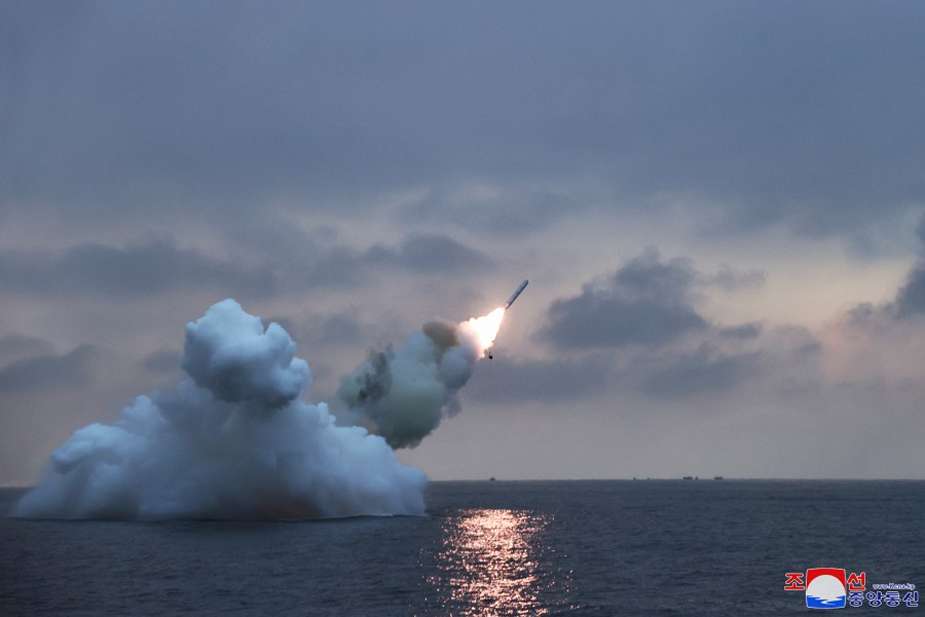Breaking news
North Korea conducts two launches of new Pulhwasal-3-31 submarine-launched strategic cruise missile.
According to North Korea's state news agency, KCNA, on January 29, 2024, North Korea conducted two test launches of a new submarine-launched strategic cruise missile (SLCM) named 'Pulhwasal-3-31,' also known as 'Fire Arrow-3-31.' This announcement followed a series of SLCM tests conducted on January 24 and 28, 2024, about ten months after the initial SLCM launch in March 2023.
Follow Navy Recognition on Google News at this link
 On January 28, 2024, North Korea conducted a second test launch of the 'Pulhwasal-3-31' missile to allegedly demonstrate its readiness for submarine deployment. (Picture source: KCNA)
On January 28, 2024, North Korea conducted a second test launch of the 'Pulhwasal-3-31' missile to allegedly demonstrate its readiness for submarine deployment. (Picture source: KCNA)
The test launch on January 24 was led by North Korean leader Kim Jong-un and was described by the Korean Central News Agency as part of an ongoing process for the renewal of the weapon system, deemed a routine activity undertaken by the North Korean Missile General Directorate and the Agency for Defense Development. Notably, this test marked the first official confirmation of the name 'Pulhwasal-3-31,' although it had not been explicitly identified as a submarine-launched cruise missile before. The missile was initially mentioned as "under development" during its first test launch on January 24th.
However, on January 28, 2024, North Korea conducted a second test launch of the 'Pulhwasal-3-31' missile to allegedly demonstrate its readiness for submarine deployment. During this test, two missiles were fired from a submarine off the coast of Sinpo Naval Base in the East Sea, with Kim Jong-un reportedly overseeing the launch.
The missiles are said to have flown for extended durations, with flight times ranging from 7,421 seconds (approximately 2 hours, 3 minutes, and 41 seconds) to 7,445 seconds (approximately 2 hours, 4 minutes, and 5 seconds), ultimately hitting their intended target. Photographs released by North Korean state media suggest that the missile was launched at an oblique angle, raising the possibility that it was ejected from a torpedo tube instead of a vertical launch tube (VLS). However, North Korea has not provided specific information about the launch platform used, the flight distance, or the identity of the submarine involved in the test.
In contrast to its predecessors, namely the 'Arrow-1' and 'Arrow-2,' North Korea has chosen to name this missile 'Pulhwasal' ('Fire Arrow'), with the numerical designation '3-31,' potentially indicating compatibility with the 'Hwasan-31' type of tactical nuclear warhead. Additionally, its white color differentiates it from North Korea's previously known cruise missiles, such as the 'Arrow-1' and 'Arrow-2,' prompting questions about its payload and capabilities, while there is uncertainty regarding whether the 'Pulhwasal-3-31' represents an improved version of a submarine-launched cruise missile (SLCM) previously unveiled by the North Korean People's Army in 2023 or an entirely new missile type.
South Korean and US intelligence authorities believe that the second test launch of the Pulhwasal-3-31 missile likely took place from the Kim Gun-ok Hero submarine, unveiled on September 6, 2023. Choi Il, the director of the Submarine Research Institute, assessed the Pulhwasal-3-31 missile's capabilities as potentially suitable for launch from both land and submarines, drawing comparisons with the Russian Kalibr cruise missile.
Such a development would align with North Korea's broader defense objectives outlined in its '5-year plan for defense science development and weapons system development,' which includes the possession of nuclear submarines and underwater-launched nuclear strategic weapons, causing concerns among several countries, including South Korea, the United States, and Japan. Available information indicates that North Korea's strategic cruise missiles possess a range of 1,000 to 2,000 kilometers, potentially targeting not only South Korea but also Japan and U.S. naval forces and military bases in the region. These missiles are believed to have a low-altitude flight profile, typically ranging between 30 to 50 meters, and a relatively moderate top speed between Mach 0.8 to Mach 0.95, which could pose challenges for detection and interception.
Additionally, on September 8, 2023, during the unveiling ceremony of the Kim Gun-ok Hero submarine at the Sinpho shipyard, North Korea categorized this submarine as a 'tactical nuclear attack submarine,' capable of launching various tactical nuclear weapons, including submarine-launched ballistic missiles (SLBMs) and cruise missiles. However, substantial uncertainties surround the submarine's operational readiness, particularly regarding its ability to effectively launch nuclear-capable missiles. Kim Jong-un's visit to a nuclear submarine construction project was also reported alongside the second test launch of the Pulhwasal-3-31, demonstrating North Korea's commitment to showcasing its military capabilities.


























